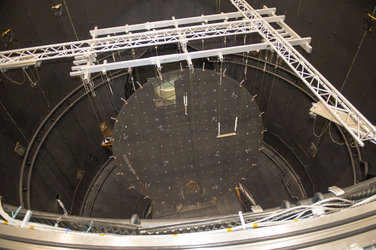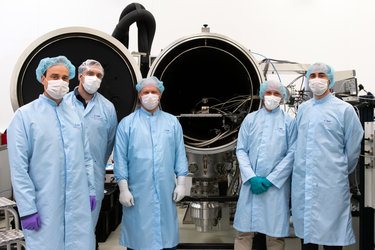Accept all cookies Accept only essential cookies See our Cookie Notice

About ESA
The European Space Agency (ESA) is Europe’s gateway to space. Its mission is to shape the development of Europe’s space capability and ensure that investment in space continues to deliver benefits to the citizens of Europe and the world.
Highlights
ESA - United space in Europe
This is ESA ESA facts Member States & Cooperating States Funding Director General Top management For Member State Delegations European vision European Space Policy ESA & EU Space Councils Responsibility & Sustainability Annual Report Calendar of meetings Corporate newsEstablishments & sites
ESA Headquarters ESA ESTEC ESA ESOC ESA ESRIN ESA EAC ESA ESAC Europe's Spaceport ESA ESEC ESA ECSAT Brussels Office Washington OfficeWorking with ESA
Business with ESA ESA Commercialisation Gateway Law at ESA Careers Cyber resilience at ESA IT at ESA Newsroom Partnerships Merchandising Licence Education Open Space Innovation Platform Integrity and Reporting Administrative Tribunal Health and SafetyMore about ESA
History ESA Historical Archives Exhibitions Publications Art & Culture ESA Merchandise Kids Diversity ESA Brand CentreLatest
Space in Member States
Find out more about space activities in our 23 Member States, and understand how ESA works together with their national agencies, institutions and organisations.
Science & Exploration
Exploring our Solar System and unlocking the secrets of the Universe
Go to topicAstronauts
Missions
Juice Euclid Webb Solar Orbiter BepiColombo Gaia ExoMars Cheops Exoplanet missions More missionsActivities
International Space Station Orion service module Gateway Concordia Caves & Pangaea BenefitsLatest
Space Safety
Protecting life and infrastructure on Earth and in orbit
Go to topicAsteroids
Asteroids and Planetary Defence Asteroid danger explained Flyeye telescope: asteroid detection Hera mission: asteroid deflection Near-Earth Object Coordination CentreSpace junk
About space debris Space debris by the numbers Space Environment Report In space refuelling, refurbishing and removingSafety from space
Clean Space ecodesign Zero Debris Technologies Space for Earth Supporting Sustainable DevelopmentLatest
Applications
Using space to benefit citizens and meet future challenges on Earth
Go to topicObserving the Earth
Observing the Earth Future EO Copernicus Meteorology Space for our climate Satellite missionsCommercialisation
ESA Commercialisation Gateway Open Space Innovation Platform Business Incubation ESA Space SolutionsLatest
Enabling & Support
Making space accessible and developing the technologies for the future
Go to topicBuilding missions
Space Engineering and Technology Test centre Laboratories Concurrent Design Facility Preparing for the future Shaping the Future Discovery and Preparation Advanced Concepts TeamSpace transportation
Space Transportation Ariane Vega Space Rider Future space transportation Boost! Europe's Spaceport Launches from Europe's Spaceport from 2012Latest

Heart of ESA vacuum testing
Thank you for liking
You have already liked this page, you can only like it once!
These four crucial hardware units are built to endure spaceflight conditions but never leave the ground. Together they form the thermal data acquisition system of the largest thermal vacuum chamber in Europe, the Large Space Simulator.
Featuring a Sun simulator that reproduces unfiltered sunshine, the mammoth LSS chamber allows entire satellites to be operated in the equivalent illumination, vacuum and temperature conditions of space for weeks on end.
Known as NgDCUs, New Generation Data Collection Units, these rarely glimpsed boxes are normally fitted into the equipment bay of the motion simulator within the LSS. This is used to rotate a satellite being tested within the cylindrical test chamber, which at 15 m high and 10 m wide is big enough to accommodate an upended London double decker bus.
Currently undergoing their biennial calibration process to make sure their accuracy remains well within specification, the NgDCUs are used to gather thermal data from within a satellite during each test campaign.
The cables that extend from each unit are connected to thermocouples and other sensors embedded within the test satellite. Each unit fits seven data cards within up acquiring test data across a maximum 54 channels, adding up to more than 1500 channels overall. These internal thermal measurements are supplemented by optical and thermal cameras mounted within the LSS.
“For typical test chambers, this kind of acquisition system would be operated outside vacuum,” explains electronics engineer Koen Debeule of ESA’s ESTEC Test Centre. “But because these units need to rotate along with the test satellite they have to be built to withstand sustained hard vacuum and temperature swings. Being built to flight quality in this way really makes them unique.”
Hardware for the NgDCUs came from Syderal in Switzerland with software supplied by Terma in the Netherlands.
Based at the ESTEC Test Centre in Noordwijk, the Netherlands, the LSS has performed pre-flight testing for many of ESA’s biggest missions, including Rosetta, Juice and Plato. The chamber incorporates a Sun simulator with up to 19 IMAX cinema-class Xenon light bulbs and liquid or gaseous nitrogen shrouds lining its walls to reproduce the chill of space.
The Test Centre is operated for ESA by European Test Services. It is the largest facility of its kind in Europe, providing a complete suite of equipment for all aspects of satellite testing under a single roof.
-
CREDIT
ESA-SJM Photography -
LICENCE
ESA Standard Licence

Reflector within test chamber

GRASS in thermal vacuum chamber

MTG-I pushed into the thermal vacuum chamber

LaRa team beside thermal vacuum chamber















 Germany
Germany
 Austria
Austria
 Belgium
Belgium
 Denmark
Denmark
 Spain
Spain
 Estonia
Estonia
 Finland
Finland
 France
France
 Greece
Greece
 Hungary
Hungary
 Ireland
Ireland
 Italy
Italy
 Luxembourg
Luxembourg
 Norway
Norway
 The Netherlands
The Netherlands
 Poland
Poland
 Portugal
Portugal
 Czechia
Czechia
 Romania
Romania
 United Kingdom
United Kingdom
 Slovenia
Slovenia
 Sweden
Sweden
 Switzerland
Switzerland
























